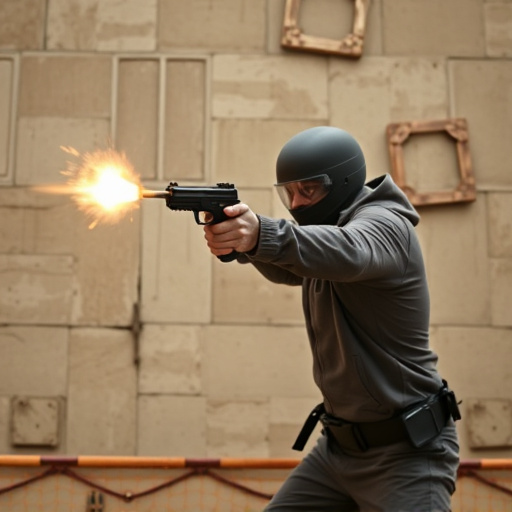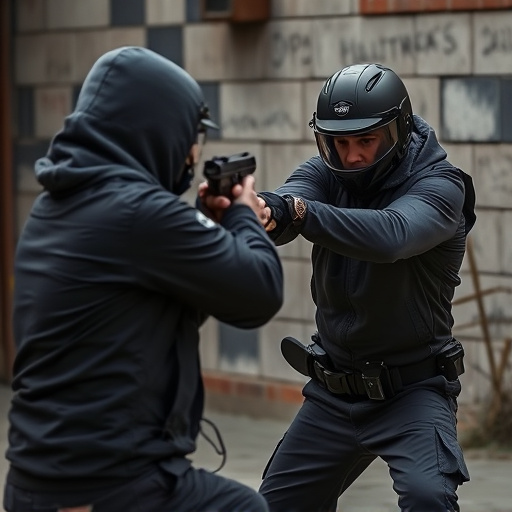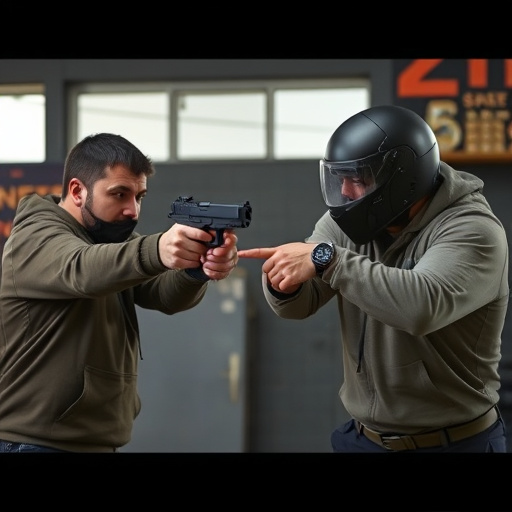Police-grade stun guns are powerful yet safe tools for law enforcement, utilizing high-voltage, low-amperage electrical currents to temporarily paralyze targets. Their effectiveness and safety depend on advanced design, construction, and wire specifications, including electrode shape, material composition, voltage levels, shot range, and discharge rates. Understanding current flow patterns is crucial for optimal device performance; this analysis ensures rapid incapacitation without severe injuries, balancing power and precision. With various models available, law enforcement can choose stun gun options with strategic electrical element placement, automatic triggers, and safety features to handle diverse scenarios effectively while minimizing risks.
In today’s world, understanding electrical current spread is crucial, especially when it comes to self-defense tools like stun guns. This article delves into the intricate science behind these devices, focusing on ‘police grade stun gun options’. We’ll explore how electrical current behaves and analyze the spread patterns that determine their effectiveness. From the technology’s fundamentals to practical applications and safety measures, discover the key factors influencing current diffusion in stun guns, empowering users with informed choices.
- Understanding Electrical Current and Its Behavior
- The Science Behind Stun Guns: A Comprehensive Overview
- Police Grade Stun Gun Design and Features
- Analyzing Spread Patterns: Key Considerations
- Factors Influencing Current Spread in Stun Guns
- Practical Applications and Safety Measures
Understanding Electrical Current and Its Behavior

Electrical current, a fundamental aspect of physics and engineering, is crucial in understanding how power flows through circuits and devices. When it comes to analyzing the spread pattern of electrical current, especially in the context of self-defense tools like police-grade stun guns, knowledge of this behavior becomes indispensable. The path of least resistance is a key principle; current seeks to flow from a high voltage source through a conductor to ground, choosing the pathway with the lowest impedance.
This dynamic interaction reveals important insights into the design and effectiveness of stun guns. By manipulating the shape and composition of electrodes and the surrounding materials, manufacturers can influence the current’s dispersion, ensuring targeted disruption of an assailant’s nervous system. Advanced options in police-grade stun gun design consider not only power output but also the strategic placement of electrical elements to optimize current spread, thereby enhancing safety and effectiveness for law enforcement officers.
The Science Behind Stun Guns: A Comprehensive Overview

Stun guns, also known as electronic control devices (ECDs), are non-lethal weapons designed to incapacitate a target through electrical impulses. The science behind stun guns involves the delivery of high-voltage, low-amperage electrical current to the body, disrupting muscle control and causing temporary paralysis. This technology has evolved significantly since its inception, with advancements in electronics and materials science leading to more compact, powerful, and reliable devices.
Police-grade stun guns are engineered to meet stringent performance criteria for law enforcement use. These options typically feature settings that allow officers to adjust the intensity of the shock, ensuring they can respond appropriately to various situations. Modern stun guns also incorporate safety features such as automatic shut-off mechanisms after a certain activation time and protective designs to prevent accidental discharge. The wide range of police grade stun gun options available today offers law enforcement agencies versatile tools for crowd control, self-defense, and tactical operations.
Police Grade Stun Gun Design and Features

Police-grade stun guns are designed with a deep understanding of the electrical current spread pattern analysis, ensuring their effectiveness and safety in critical situations. These devices typically feature robust construction to withstand harsh environments and rigorous use. The design focuses on delivering a powerful electric shock while adhering to strict safety standards. Advanced technology enables precise control over current flow, minimizing collateral damage and maximizing the stun’s impact.
In terms of Police Grade Stun Gun Options, users can choose from various models with different voltage levels, shot ranges, and discharge rates. Some advanced models incorporate smart features like automatic triggers, multiple activation modes, and built-in safety mechanisms to prevent accidental discharges. The ergonomic design ensures comfort during prolonged use, making them indispensable tools for law enforcement officers and security personnel facing potentially dangerous situations.
Analyzing Spread Patterns: Key Considerations

Analyzing the spread pattern of electrical current is a critical aspect when considering Police Grade Stun Gun options. It offers valuable insights into the device’s effectiveness and safety features. By studying how the current flows and disperses, experts can assess the stun gun’s impact on an attacker, ensuring it provides a safe and powerful response without causing excessive harm. This analysis involves understanding various factors such as current intensity, duration, and distribution along the target area.
When evaluating stun guns, the specific spread pattern can indicate the device’s ability to incapacitate an assailant quickly. For instance, a well-designed stun gun should have a concentrated current flow that disrupts muscle control and coordination without causing severe injuries. The key consideration here is balance—ensuring the stun gun delivers enough power to subdue but not enough to leave lasting physical damage. This precision in design can be a deciding factor when it comes to choosing the best Police Grade Stun Gun options available on the market.
Factors Influencing Current Spread in Stun Guns

The spread pattern of electrical current in stun guns is influenced by several key factors, which can significantly impact their effectiveness and safety. One of the primary considerations is the stun gun’s design and construction. Advanced Police Grade Stun Gun Options often incorporate innovative features like specialized electrodes and high-current delivery systems, allowing for a more precise and widespread current flow, ensuring maximum stun effect while minimizing collateral damage.
Additionally, the type and gauge of the conducting wires play a crucial role in shaping the current spread. Thicker wires generally conduct and distribute electricity more efficiently, resulting in a broader area of impact. This is particularly important in situations requiring swift immobilization of subjects over larger surfaces. The choice between different stun gun models with varying wire configurations can thus enhance operational versatility for law enforcement officers, making them better equipped to handle diverse scenarios.
Practical Applications and Safety Measures

Practical Applications and Safety Measures
In addition to their use in scientific research, electrical current spread pattern analysis has numerous practical applications, particularly in the field of personal safety devices. One notable example is the Police Grade Stun Gun Options, which leverage this technology to deliver powerful electric shocks for self-defense purposes. These stun guns are designed to incapacitate an assailant temporarily, providing users with a crucial window of opportunity to escape or seek help. By understanding how electrical current spreads through the body, manufacturers can optimize the performance and safety of these devices.
Safety measures are paramount when dealing with electrical energy. In the context of stun guns, this includes ensuring proper training for users to minimize the risk of unintended harm. Proper handling procedures, awareness of local laws, and understanding the device’s limitations are essential components of safe usage. Additionally, ongoing research into current spread patterns helps identify potential risks and refine safety standards, making these devices more effective and less prone to adverse effects.
Electrical current spread pattern analysis is a critical component of understanding the effectiveness and safety of police-grade stun guns. By examining how current spreads across the body, we can optimize design and usage to ensure optimal disruption with minimal side effects. Among the various factors influencing current spread, choosing the right Police Grade Stun Gun Options plays a pivotal role. Through this analysis, we’ve explored key considerations and practical applications, highlighting the importance of continuous research and safety measures in enhancing stun gun technology for law enforcement professionals.
